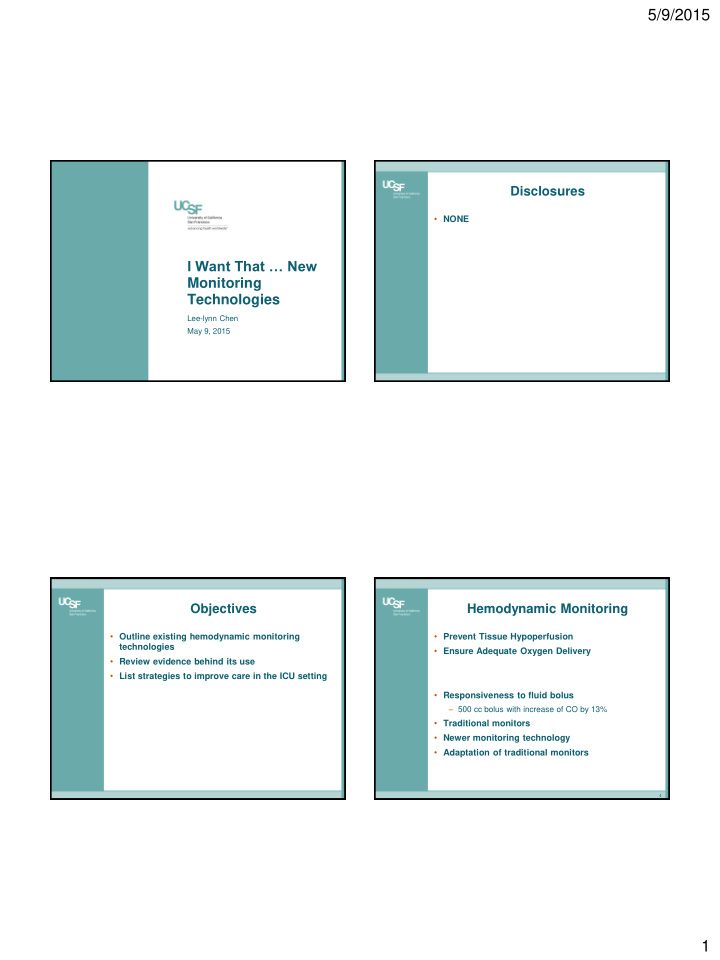



5/9/2015 Disclosures • NONE I Want That … New Monitoring Technologies Lee-lynn Chen May 9, 2015 Objectives Hemodynamic Monitoring • Outline existing hemodynamic monitoring • Prevent Tissue Hypoperfusion technologies • Ensure Adequate Oxygen Delivery • Review evidence behind its use • List strategies to improve care in the ICU setting • Responsiveness to fluid bolus – 500 cc bolus with increase of CO by 13% • Traditional monitors • Newer monitoring technology • Adaptation of traditional monitors 4 1
5/9/2015 Case Non-Invasive Blood Pressure Cuff • 58 yo alcoholic male presenting with acute pancreatitis transferred from an outside hospital after receiving 10 liters of crystalloid for resuscitation. Currently, intubated and sedated. • How do you decide whether to give more fluids versus initiating vasoactive medications? • BP 80/50, HR 100 5 6 Arterial Blood Pressure Monitoring The Pulmonary Artery Catheter 7 8 2
5/9/2015 Other helpful measures BP = CO X SVR 9 10 Frank-Starling Curve Why not give fluid to everyone? Michard & Teboul. Chest 121:2000-8, 2002 11 12 3
5/9/2015 Goldilocks for Fluids Passive Leg Raise Teboul and Monnet. Intensive Care Medicine 2008 13 14 Passive Leg Raise Esophageal Doppler 15 16 4
5/9/2015 How does the Esophageal Doppler work? Descending Aorta Flow Profile 17 18 Anatomy of the waveform 19 20 5
5/9/2015 Hypovolemia Left Ventricular Failure 21 22 High Afterload Waveform Changes 23 24 6
5/9/2015 Limitations Protocol Driven Patient Care • Intra-aortic balloon • Thoracic aortic aneurysm, stents, aortic coarctation • Fast atrial fibrillation (irregular systoles) • Aortic regurgitation (poorly defined end of systole) • Aortic valve disease (poorly defined start of systole) • Access to head BMJ 2004, 329:258-261 25 26 Protocol Driven Patient Care Nurse delivered flow monitor protocol 27 28 7
5/9/2015 Results Bioreactance 29 30 Pulse Contour Analysis Effects of Mechanical Ventilation • Relationship between BP, SV, arterial compliance and SVR • Pressure-volume conversion algorithms – Indicator Dilution CO measurement (LiDCO, PiCCO) – Arterial impendence and demographic (FloTrac) – No calibration or preloaded data needed (MostCare) 31 32 8
5/9/2015 Pulse Pressure Variation 33 34 Predictive Value of Techniques Stroke Volume Variation • PPV/SPV/SVV – surrogate measure of relative preload responsiveness • High sensitivity and specificity compared to traditional indicators of fluid responsiveness • Limitations – Mechanically Ventilated (PEEP) – No arrhythmias – Vascular Tone 35 36 9
5/9/2015 PVI 37 38 Brain/Tissue Oxygen Monitor Assessing volume responsiveness • Passive Leg Raising • Pulse Pressure Variations • Systolic Pressure Variations • Stroke Volume Variations 39 40 10
5/9/2015 Take Home Messages • Audit your practice • Standardize Care • Identify Barriers at your institutions • Improve your Knowledge QUESTIONS? 11
Recommend
More recommend